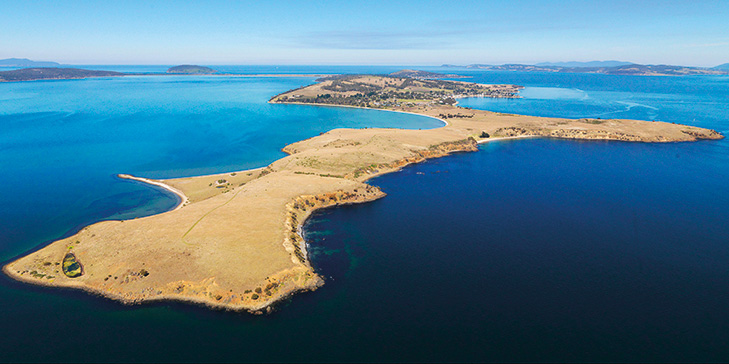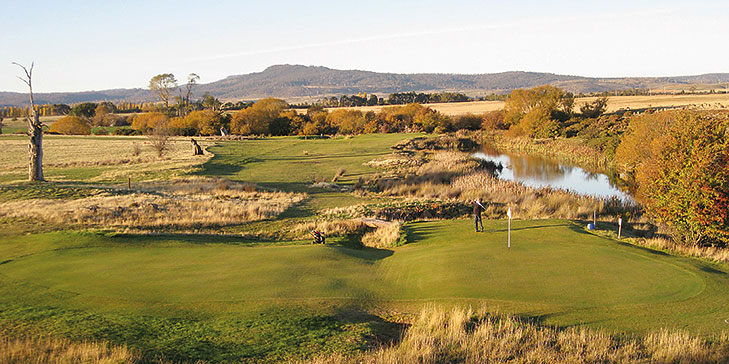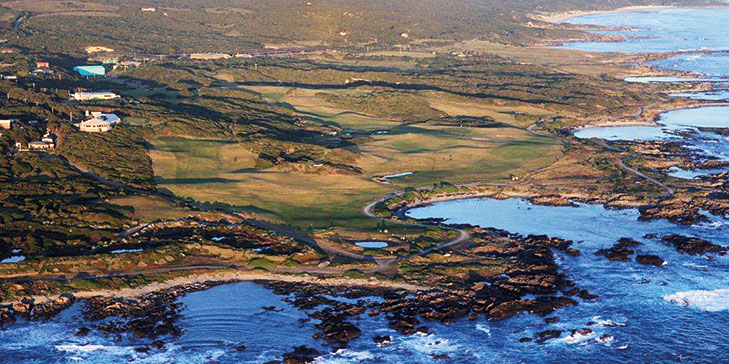The golf business is populated by romantics.
Spotting a great piece of land and conceiving that golfers from around the world might be prepared to travel to practice their hobby on that site, if only it could be turned into a good enough course, is so contrary to sensible business thinking that only dreamers would feel that way.
Yet, of course, sometimes dreamers get it right. Stephen Goodwin’s book Dream Golf describes in great detail how Mike Keiser went against the advice of every consultant he ever hired – apart from one, Howard McKie – to build Bandon Dunes in Oregon, now a five course behemoth and one of the most successful pure golf developments in the game’s history. Keiser’s legacy now spreads across the world: Ben Cowan-Dewar of Canada’s Cabot Links, another project partially funded by the Baron of Bandon, is building his second course. Developers in every continent have been inspired by Keiser’s ‘build it and they’ll come’ philosophy. And, in the far-flung Australian state of Tasmania, one young man, a partner of Keiser from way back, is living the dream.
The golf world first heard of Greg Ramsay when Barnbougle Dunes made its debut at the end of 2004. Ramsay, not long returned from a year in St Andrews where he tended bar, caddied at Kingsbarns and made golfing contacts, saw the immense potential of the dunes belonging to local farmer and hotel owner Richard Sattler. He convinced architect Tom Doak to fly to Tasmania to inspect the property. Doak had recently completed Pacific Dunes at Bandon, and vouched for the quality of the Barnbougle site to Mike Keiser. The subsequent collaboration led to the creation of one of the world’s greatest new courses.
 Ramsay’s Arm End project will see a peninsula in the south of Tasmania redeveloped for public recreation, with cycling, walking and a golf course designed by Neil Crafter and Paul Mogford
Ramsay’s Arm End project will see a peninsula in the south of Tasmania redeveloped for public recreation, with cycling, walking and a golf course designed by Neil Crafter and Paul Mogford
The story of how Sattler, Ramsay and some of the other original Barnbougle investors ended up in an Australian courtroom arguing over the plans to develop Lost Farm, the second course on Sattler’s property is long and tortuous. No-one emerged unscathed. But perhaps Ramsay’s greatest attribute is unending enthusiasm. Scarred he may be, but broken he is not. If he brings off even a proportion of the projects – both golf and otherwise – that are brewing in his fertile brain, Barnbougle will be a distant memory.
Ramsay grew up on a farm in the small village of Bothwell in Tasmania’s central highlands. No ordinary farm though; Ratho was the site of the first golf course in Australia, created by Scottish immigrants in the first half of the nineteenth century. Restoration of the original twelve hole course, a project supported by the Australian government, offers a true nineteenth century golfing experience and a warmup to playing the full 18 hole championship layout.
His reach spreads across Tasmania and beyond. Whisky is another area of interest. Ramsay was involved in the creation of the forthcoming Kingsbarns Distillery, a project to create a single malt whisky producer in the St Andrews area, led by fellow former Kingsbarns caddie Doug Clement, and now backed by the Wemyss Malts company. He’s been working with a number of start-up distilleries elsewhere around the world too, and is currently marketing a large tranche of malt bought from New Zealand’s last distillery, which closed in the late 1990s. But it’s golf – along with his native Tasmania – that remains his first love.
Flagship among Ramsay’s golf ventures is the Arm End project outside the island’s capital, Hobart. Ramsay’s proposal calls for the South Arm peninsula, a narrow spit of land across the bay from Hobart’s city centre, surrounded by water on three sides, to be redeveloped as a public recreational resource, with cycling tracks, walking trails, and a golf course, which is to be designed by Australian architects Neil Crafter and Paul Mogford. “The peninsula is a beautiful piece of land, but it’s a degraded environment that has been covered with a lot of non-native grasses and trees for many years,” says Ramsay. The local council granted conditional approval for the development in December, though the proposal has proved controversial, with some members of the community dubious of the potential for environmental benefits, concerned about the leasing of public land to a private developer and worried about the impact of golf traffic on the narrow roads of the peninsula. Of over 150 responses to a public consultation though, 133 were in favour, citing job creation, the sustainability of the plans and the reduction of bushfire risk, as well as the community benefits of Ramsay’s scheme.
Architect Neil Crafter says the potential of Arm End is immense. “I believe we can build an Australian top ten course on the site – it’s that good,” he says. “Not only is it sandy, but being surrounded by water on three sides means there are great views wherever you look. Our routing has the water in view from every hole – it will be very scenic.” Ramsay has put together a consortium of investors to support the project, and, with the conditional approval from the authorities, the team hope to start construction at Arm End before the close of 2014.
 Ramsay grew up on a farm that was the site of Australia’s oldest course, Ratho Links. He has overseen a restoration project that allows visitors to experience golf as it was during the 1800s, as a warmup to playing the full 18 hole championship layout (see www.rathofarm.com)
Ramsay grew up on a farm that was the site of Australia’s oldest course, Ratho Links. He has overseen a restoration project that allows visitors to experience golf as it was during the 1800s, as a warmup to playing the full 18 hole championship layout (see www.rathofarm.com)
Crafter and Mogford are working with Ramsay on another project on the eastern coast of Tasmania. The Bicheno golf club currently has a nine hole course adjoining, but not making use of, some spectacular sand dunes. Ramsay has brokered a deal between the club and local landowner Peter Johnstone to construct an additional nine holes in the dunes, plus 62 houses on neighbouring land. Unfortunately, Johnstone’s home was affected in the huge bushfires that swept the Bicheno area a year ago, but both developer and architect say the project remains on track, and could also start in 2014.
Crafter and Mogford aren’t the only golf architects set to benefit from Ramsay’s ambitions for golf in Tasmania. If American architect Mike Nuzzo had made the leap from aeronautics to golf design ten years earlier, the universal acclaim given to his debut project, Wolf Point, a remarkable course built for a single owner on pancake-flat south Texas ranch land, would surely have seen him move on and build several more high-profile courses before the industry ground to a halt in 2008. As it was, Nuzzo has struggled to find another project worthy of his abilities, though he has done excellent work on a number of renovations.
Ramsay has set Nuzzo a challenge. At Orford on the island’s east coast, he is trying to revive a long-stalled golf and housing development that was to feature a course designed by Greg Norman’s practice. The Norman firm’s design, though, was costed for a sum that is beyond the ability of developers to raise in this new market. But Nuzzo thinks he can make the course work for significantly less money.
 Ramsay is helping to promote a nine-hole course on King Island, where two new projects are expected to generate a boom in golfing visitors
Ramsay is helping to promote a nine-hole course on King Island, where two new projects are expected to generate a boom in golfing visitors
The site for the Solis development, at Louisville Point outside Orford, extends to 272 hectares, and has a long-standing planning approval for 620 houses, a spa and visitor cabins, as well as the golf course. Ramsay has been hired by the local council to try and revive the development, and is working with Nuzzo to come up with a revised course design. Watch this space!
Tasmania is not Ramsay’s only focus though. Between the island and the Australian mainland sits King Island, which has recently become a hotspot for golf. Two projects, one by Australian architect Graeme Grant, and the other by American Mike DeVries, are currently in construction on King Island – but Ramsay is working with the island’s existing nine hole course to market its charms, and hopefully capture a good share of the expected boom in golfing visitors when the new courses are completed. “King Island is one of the world’s greatest nine hole courses,” says Ramsay. “In fact, I’m really keen to invite people who have seen other nine holers regarded as among the best in the world – such as Royal Worlington & Newmarket in England, and the Dunes Club outside Chicago, to visit King Island and make their mind up as to which is really best! So we have been working with the club to develop fly, stay and play packages, as well as putting together international linkages with some other famous nine hole courses.”
This article first appeared in Golf Course Architecture January 2014.